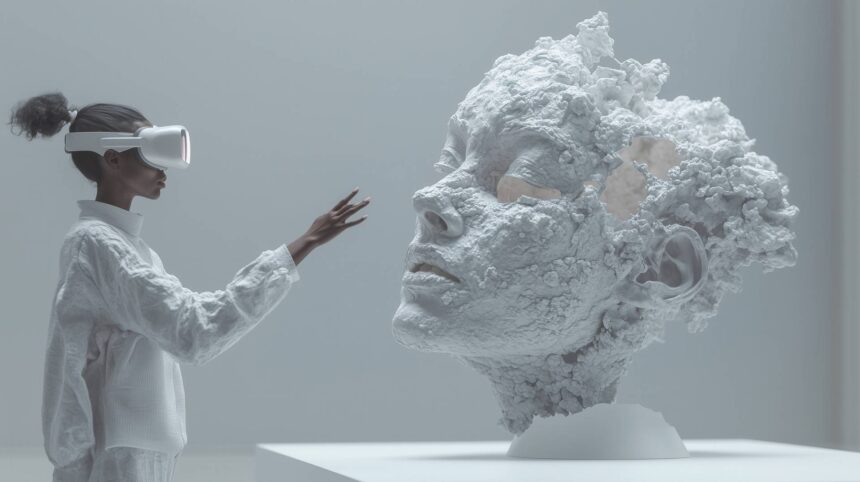In a world where language fractures under the weight of speed, data, and distortion, Hybrid Collapse proposes something rare: a new cultural grammar. Blending sound, AI-generated imagery, theory, and its own evolving glossary, the project invites us to navigate collapse not as chaos, but as coded structure — a system we can learn to read.
In an age of cultural acceleration and cognitive overload, language itself begins to fragment. Words lose meaning. Symbols blur. Concepts collapse under the pressure of endless content. Hybrid Collapse responds to this not with simplification, but with structure — a deep integration of sound, image, and thought that forms its own semiotic system.
More than an art project, Hybrid Collapse is an attempt to compose a new cultural grammar for the algorithmic age. Its music, visuals, and essays are not isolated artifacts, but parts of a larger framework — one that helps us perceive what remains invisible in daily life: power, ritual, identity, myth, and machine logic.
Ritual Systems for a Fractured World
Rather than presenting finished narratives or clear messages, Hybrid Collapse builds rituals of ambiguity. Its AI-generated visuals loop like cybernetic ceremonies. Its sound design unfolds like an architecture of tension — broken rhythms, vocal distortion, and glitch textures. And its essays serve not as explanation, but as critical wayfinding tools.
The project resists the flattening forces of modern media: virality, clarity, optimization. Instead, it proposes slowness, opacity, and symbolic resonance. Aesthetic choices are never arbitrary — they emerge from a conceptual core and feed back into it. This recursive structure is key to what makes Hybrid Collapse more than a multimedia project — it is a posthuman language system.
Glossary: Toward a Living Philosophy
One of the most unique aspects of Hybrid Collapse is its glossary system — an evolving index of core terms and concepts that form the backbone of the project’s ideological and aesthetic logic.
This is not a dictionary in the traditional sense. The glossary is:
-
Philosophically grounded — Drawing from thinkers like Foucault, Haraway, Agamben, Deleuze, Braidotti, and Han, each term reflects a contemporary condition: from control society to algorithmic intimacy, from ritual repetition to digital flesh.
-
Linked to artworks — Each glossary entry connects directly to relevant tracks, visuals, and essays, creating semantic cross-references between theory and experience.
-
Written in a hybrid tone — Academic precision meets poetic language. These are not dry definitions, but micro-essays, atmospheres of thought.
-
A living structure — As the project evolves, so does the glossary. New entries are added with each new release, building a theoretical spine across time.
The glossary doesn’t simplify the project — it deepens it. It invites the audience not just to consume but to explore. To learn the language of the system, and in doing so, to see how meaning is made, layered, and collapsed in the posthuman condition.
This reflexive dimension transforms Hybrid Collapse from a closed artwork into an open knowledge architecture — one that can grow, branch, and integrate new conceptual matter.
From Sensation to Structure
Where most contemporary art drifts toward affect and away from thought, Hybrid Collapse insists that the two must work together. The emotional force of the music, the eerie charge of the visuals — these are not separate from the theoretical core. They are expressions of it, rendered in sensory form.
A viewer might first be drawn in by aesthetics: latex goddesses, posthuman twins, flooded temples. But the deeper impact comes through structure: why those images recur, how loops generate meaning, how bodies reflect systems of power and sexuality.
The result is not a spectacle, but a coded experience — one that teaches you how to see it as you go.
Collapse as Syntax
Ultimately, Hybrid Collapse is not just about collapse — it thinks in collapse. It uses recursive forms, semantic density, sonic repetition, and visual mirroring to simulate what it means to live inside systems that no longer hold.
But rather than offering escape or critique, the project offers syntax — a new way of arranging fragments into something intelligible. Not clean. Not linear. But meaningful nonetheless.
And that is where the glossary plays its deepest role: not just as a reference, but as a method of thought.
Conclusion: A Culture That Can Think Itself
We don’t just need art that reflects the world — we need art that thinks it. That builds tools to navigate, name, and reorganize perception. Hybrid Collapse is one such project: a hybrid of sound, image, theory, and system — but also a language in construction, waiting to be learned.
